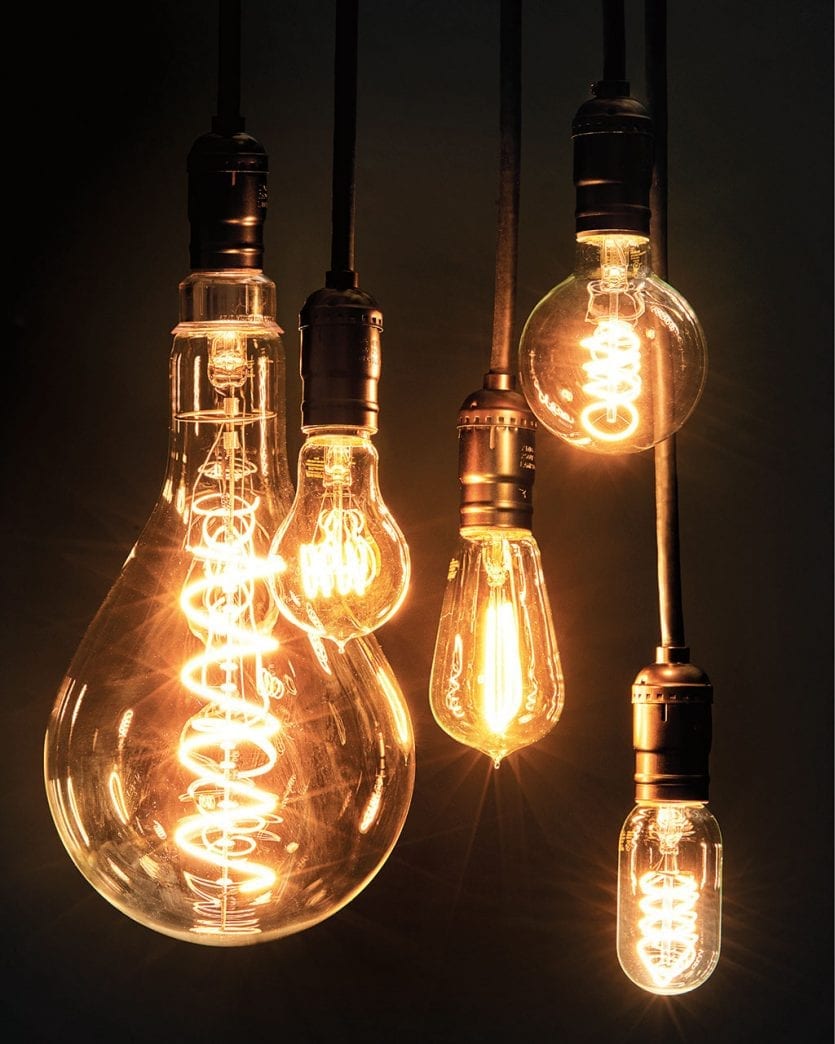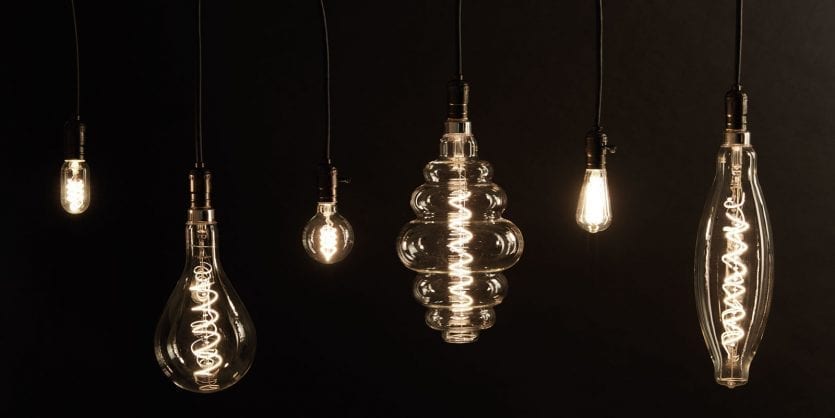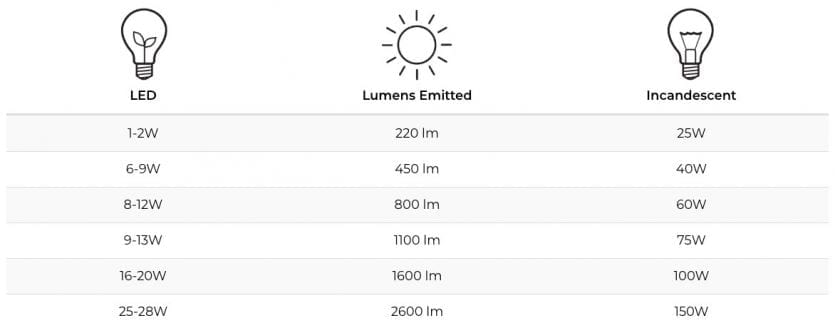This LED lighting post was updated in August 2022.

If you’ve ever listened to the podcast, you know how much we talk about lighting and how it’s so important to the look and feel of the room. In fact, nearly all of our interior designer guests talk about how it’s the #1 challenge they see in people’s homes. While it’s a complicated topic, we’ve done our best to pull everything you need to know into one definitive guide on how to light your room with LED lighting.

Lightbulbs
LED vs. INCANDESCENT
First, let’s talk about how LED lighting and incandescent lighting are different. Incandescent bulbs create light by heating the filament in the center of the bulb and making that filament glow. In an LED (or light emitting diode) bulb, electricity travels through a microchip which then lights the filament light source. The heat is reabsorbed into the bulb to prevent it from overheating and burning out.
That’s the gist of why they’re different, but here’s what you need to know: an LED light bulb creates the same amount of light but with far less energy used. They also last far longer than incandescent bulbs and use less energy, meaning they cost less over time.
LUMENS AND WATTAGE
Here’s where people get confused — they assume the wattage of the bulbs (40W, 60W, or 90W) is how much light a bulb gives off. In reality, the wattage is how much energy the bulb uses. A bulb’s lumens indicate how much light it gives off. Here’s our handy guide to help you sort it all out:
WARM LIGHT vs. BLUE LIGHT
Naysayers of energy efficient bulbs criticize the temperature of LED lighting, saying the light they give off isn’t warm enough. In reality, LED light bulbs can pretty much match the light temperature of any other bulb, so if you’re unhappy with the quality of light your current LED bulb is putting off, you probably need a warmer LED. The fact that it’s LED isn’t the problem — you likely just bought the wrong temperature bulb. But that’s an easy fix! The temperature of light is measured in degrees Kelvin, and a traditional incandescent bulb typically produces light with a temperature of 2700K to 3000K. When you’re shopping for LED bulbs, it’s the Kelvin you want to pay attention to.

BULB SIZES AND SHAPES
We’ve talked all about the mechanics of lightbulbs, but we haven’t mentioned the aesthetics. If you have a chandelier or pendant without a shade, you’ll want an exposed bulb that looks nice. There are so many fun and funky shapes that will give a fixture with an exposed bulb tons more personality.
SMART LIGHT BULBS
Smart LED WIFI light bulbs give you total control of your lighting. You can change the light to a range of colors, and customize scenes for routines like bedtime with special lighting set to start at a specific time. Since the functions are controlled via your phone, there’s no more getting up if you forgot to turn off the lights. They’re also compatible with other popular smart home devices, including Amazon Alexa and Google Home. These programmable light bulbs work by using your existing wi-fi network, so no special hub is required, and can be accessed from outside too.
See all of our lightbulbs here.
To give a simple pendant light, like our Eldridge Pendant, a little more oomph, try an oversized bulb with a funky shape. Or if you want a simple bulb, consider how the shape of the filament in the bulb can make a statement.
How to Light Your Room
AMBIENT vs. TASK vs. ACCENT
When lighting your room, you want to include all three types of lighting — ambient, task, and accent. What do each of these mean, you ask?
Ambient — Consider this the general lighting for your space, so in many homes, this means canned lights in the ceiling. We like to keep canned and overhead lighting on dimmers so you can control the amount of light it’s giving off, but ambient lighting is the first layer you’ll want in your room.
Task — Task lighting is any lighting you want to include that serves a particular function. So think about under-cabinet lighting in the kitchen that illuminates a workspace, a reading lamp by an armchair, or a desk lamp. Not every room needs task lighting, but you’ll find most will.
Accent — Accent lighting is often the most overlooked, but it also does the best job setting the mood of your space. Lamps and sconces are the most common type of accent lighting, and a rule of thumb is that you want at least 3 different accent lights in each room. Try to illuminate every corner of your room so there are no dark spots!
DIMMERS AND LAMPSHADES
Dimmers are a decorators best friend because they allow you to control the amount of light each fixture is giving off. At the very least, you’ll want dimmers on all of your overhead lighting!

Like dimmers, lampshades control how much light a particular bulb casts in the room — they’re more than just an aesthetic element of your lamp. Different shades will cast different amounts of light around your space. A simple white linen or paper shade will cast the most light around your room, while a metallic lined shade or black shade will cast light up and down. A woven shade will cast most of its light up and down, with dappled light around the edges.
Need help picking the right size and shape lampshade? See our How To Guide.
CREATE A PLAN
For your most used rooms (like kitchens and living rooms), you may want to create a lighting plan. Start by using our Room Planner to create a layout of your room with dimensions and any large furniture pieces.
In the layout, add in your first layer of ambient lighting with any overhead fixtures and canned lights.
Next, consider what tasks you’ll be performing in the room. If you’re in the kitchen, where are the hardest working areas of your kitchen? Add extra lighting in those spots, like your largest workspace, your sink, and above your stove. Be sure you have light sources casting light in those areas.
Next, bring in accent lighting both as an aesthetic addition to your room and to bring more light to dark corners. For example, if you have a side table in a living room, a table lamp is a natural addition. If you have dead space in a room, consider adding a floor lamp and a chair. A blank wall is the perfect spot to add a wall sconce — it’s both decorative and functional.
Here’s a good rule of thumb about how much lighting you’ll need:
For a 250 square foot room, you’ll want about 5000 lumens.
Have More Lighting Questions? Read these helpful posts below:
- How to Pick the Perfect Lampshade
- How to Select the Right Chandelier
- Lighting 101
- Living Room Lighting: How to Layer More Light into Your Space
To stay up to date with all things How to Decorate, sign up for our monthly newsletter.










Ellen
Caroline,
This was so informative! Thanks for the straight-to-the-point, well-organized primer on lighting, especially the LED / incandescent table!
pat snyder
This is such great information. Using the very dull and poor lighting of LEDs is a problem.
Pat